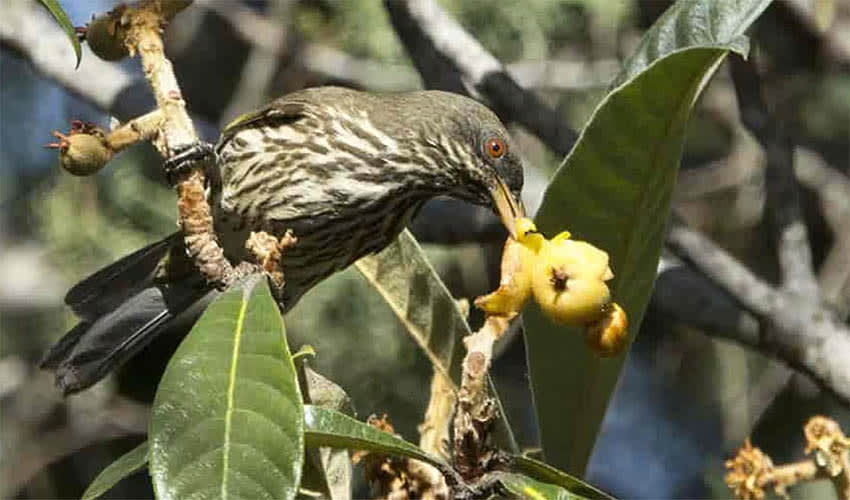Passeriformes – Passerine
This dominant order represents 60% of birds sometimes known as perching birds or songbirds
These perching birds, or songbirds, represent the largest order of birds, encompassing more than half of all known bird species. They are characterized by an anisodactyl toe arrangement, which means they have three toes pointing forward and one toe pointing backward. This configuration is particularly well-suited for gripping branches and other perches, hence their common name.
Spanning a remarkable range in size, Passeriformes can be as petite as the tiny Goldcrest, which is often only 7.6 cm (3 inches) in length, to the imposing ravens and lyrebirds, with some of the latter reaching up to 1 meter (39 inches) in length when including their extravagant tail feathers. Notably, the ribbon-tailed Astrapia, a type of Bird of Paradise, can boast tail feathers that nearly double its body length, reaching up to 1.4 meters (45 inches).
The diversity of Passeriformes extends beyond their size and includes a vast array of lifestyles and habitats. As one of the smallest, the New World flycatchers inhabit a wide range of environments, from dense forests to urban areas. On the other end of the spectrum, ravens and crows are known for their intelligence and adaptability, thriving across various landscapes around the globe.
Within this order, you’ll find melodious songbirds such as warblers, which include some of the most colorful and vocal birds. The ability to produce complex vocalizations is a trait that has evolved in many Passeriformes, leading to the wide variety of songs heard in nature.
With over 6,000 species, the order Passeriformes showcases an astonishing array of evolutionary adaptations. They occupy nearly every habitat, from the driest deserts to the wettest rainforests and from sea level to mountainous regions. Their diets are just as varied, ranging from seeds and fruit to insects and small animals. Their social structures can be complex, with some species living solitary lives while others are highly social, forming large flocks that can number in the thousands.
Families in this order
The world’s largest and most diverse zoological family of birds
They’re like living paintbrushes, with feathers that come in every shade imaginable – fiery reds, vibrant blues, sunny yellows, and even inky blacks
Their name comes from the intricate, somewhat “oven-like” clay nests constructed by the horneros
Some have thick, strong beaks for cracking tough seeds, while others have smaller, more delicate beaks for eating tiny seeds
Known for their elaborate and melodious songs, with some species capable of mimicking other birds and sounds
Their rapid life history and efficient reproduction may contribute to their susceptibility to brood parasitism
Stands out as a group of melodious songsters
This family of nectar-sipper replaces hummingbirds in the Old world
Their plumage comes in a kaleidoscope of colors – fiery reds, sunny yellows, calming blues, and everything in between
The family with the heaviest & smartest songbirds
Some species are brightly colored, while others have evolved more cryptic, camouflaged patterns
Widespread medium-sized passerine birds often considered invasive species
Family of social, specialized nest builders songbirds with conical beaks
With their vibrant plumage, versatile feeding habits, and enchanting songs, they add a touch of color and charm to the avian world
Among the most beloved songbirds, which symbolizes the countryside and pastoral beauty
With slender bodies, long pointed wings, and often forked tails, they’re perfectly adapted for life on the wing
Known for their agile and acrobatic behavior as they search for insects among the leaves of trees and bushes
Their songs and calls, ranging from sweet and melodic to chirping and trilling, add a delightful chorus to the natural symphony
Enigmatic ground-dwelling birds, blending into the forest floor and captivating with their unique calls
Renowned for their vibrant and colorful plumage
Orioles of the warmer parts of the Old World
You’ll often find them hopping around on bird feeders, enjoying a tasty snack
Once a young indigobird or whydah learns the song of its host species while being raised, it will stick with that song for life
Often called “butcher birds” because of their unusual habit of impaling their prey on thorns or barbed wire
If you’ve ever imagined birds painted by an artist who ran out of restraint, these would be it!
Known for their melodious songs, making them both visually and audibly appealing to bird enthusiasts
The family of tiny songbirds
Deforestation poses a significant risk to these birds, diminishing their suitable habitats and disrupting their natural food sources
Some of the smallest birds on the planet, not much bigger than a golf ball!
Due to their reliance on clean, fast-flowing water, they are considered excellent indicators of freshwater ecosystem health
The family of large warblers
Some males are just show-stoppers with their spectacular heavenly & unique appearance!
The majority of species are found in Asia, with a smaller presence in Africa
The berry-drunk dandies of the north
Can eat more than 100 ticks a day—imagine how helpful that is for their animal hosts!
They’re particularly fond of following ant swarms, snatching up any insects that get caught in the feeding frenzy
The family of true sparrows and relatives
Living proof that beauty, art, and imagination aren’t limited to humans
Can trick you into thinking that you hear multiple different species at once
Native to the Caribbean region where palm trees are abundant









































